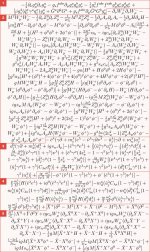Don't read about Godel and his diagonal proof (among his other accomplishments), it apparently drove him mad!Far too much damn probability in all this quantum stuff. I prefer things that are pinned down. Exact. Precise. Observable.

I can confirm that you are referring to a mathematical description of the Standard Model of particle physics written in Lagrangian form.Galu, Can you just through this quickly and confirm that said equation is on the right track please.
Despite appearances, the Lagrangian is one of the easiest and most compact ways of presenting the theory.
If you look at the attachment showing the Lagrangian, Section 1 is specific to gluons, Section 2 is dedicated to the interactions between bosons, Section 3 involves the weak force plus interactions with the Higgs field, and Sections 4 & 5 clear up some mathematical redundancies by referring to virtual particles called ghosts.
EDIT: The professor of physics who transcribed the attached Lagrangian from a theoretical physics reference work noted a sign error in the original equation and corrected it!
Attachments
Last edited:
P.S. If you want to know more, look here: The deconstructed Standard Model equation | symmetry magazine
So, you got mugged. Or you had a mugshot.
I like this different article about "Cosmic Inflation".
The last bit shows these people do have their jokes.
I like this different article about "Cosmic Inflation".
Oh noes... We're gonna have "flat universe" people starting to form mobs now...According to the theory of inflation, the expansion rate of the universe exploded in its earliest moments and then slowed. This happened as a quantum field called the inflaton field underwent a transition that pushed things apart before settling into a phase of normal gravity. The first part, the rapid expansion, would have diluted any matter and energy already present when inflation started. The second part would have released a new batch.
Luckily for those of us who appreciate the universe as it is today, the energy released was just the right amount to drive the universe toward flatness, Guth says.
The last bit shows these people do have their jokes.
“There is a limit to the data and a causal limit to what we can see in the universe consistent with the finite speed of light,” Silverstein says. But “it is amazing how much we can see and deduce, so this remaining uncertainty is not the end of the world.”
In fact, it’s only just the beginning.
Last edited:
One interpretation of gravity that I like because it is quite simple, is that the free space properties of permitivity and permeability relate to the plank length matrix of virtual particles (electron - positron pair, sort of) through which electromagnetism propagates, interactions between these particles allowing the vibration to be propagated (aether). Then for gravity, we really are considering a gradient of space density; the light speed reducing with increased density due to the distortions of massive objects. So properties of gravity don't depend on a graviton interaction (like the other forces do with their photons etc.)
If the event horizon around a massive object, at which light speed is zero, is compressed to infinitely dense, then beyond the event horizon has no calculable meaning.
This allows a natural 3 dimensional visualisation of space, and accomodates the variation in time and matter (dilation and contraction) as first stated by Lonrentz when evaluating the null result of Michaelson-Morley.
If the event horizon around a massive object, at which light speed is zero, is compressed to infinitely dense, then beyond the event horizon has no calculable meaning.
This allows a natural 3 dimensional visualisation of space, and accomodates the variation in time and matter (dilation and contraction) as first stated by Lonrentz when evaluating the null result of Michaelson-Morley.
But this is not necessarily the case as per post#7724. However since as you put it, light speed at the event horizon is zero, how can density be equivalent to air?If the event horizon around a massive object, at which light speed is zero, is compressed to infinitely dense, then beyond the event horizon has no calculable meaning.
I can confirm that you are referring to a mathematical description of the Standard Model of particle physics written in Lagrangian form.
Despite appearances, the Lagrangian is one of the easiest and most compact ways of presenting the theory.
If you look at the attachment showing the Lagrangian, Section 1 is specific to gluons, Section 2 is dedicated to the interactions between bosons, Section 3 involves the weak force plus interactions with the Higgs field, and Sections 4 & 5 clear up some mathematical redundancies by referring to virtual particles called ghosts.
EDIT: The professor of physics who transcribed the attached Lagrangian from a theoretical physics reference work noted a sign error in the original equation and corrected it!
It’s clear that we have to find a more compact way of understanding the universe.
Pfft!See on Twitter
“No offense to Einstein, but it took him years to figure out General Relativity, whereas I had it nailed in one undergrad class”
Don’t you just love the way knowledge works?

If the event horizon around a massive object, at which light speed is zero, is compressed to infinitely dense, then beyond the event horizon has no calculable meaning.
Pete, you have picked up an inconsistency in that, as a black hole becomes more massive, the event horizon is not "compressed", but expands in radius. The density of the black hole - as defined by its mass divided by the volume contained within its event horizon - becomes less.But this is not necessarily the case as per post #7724.
It is at the singularity where it is hypothesised that matter is compressed to infinite density.
Perhaps pde2000 has simply conflated event horizon with singularity, or is meaning something deeper. However, I agree with him that "beyond the event horizon has no calculable meaning" in terms of our current knowledge of physics.
It seems counter intuitive that density should decrease beyond the event horizon. Especially that lightspeed could be zero there but not beyond it. So if one were to survive entrance into a massive black hole such as those at the center of a galaxy, they would 'see' stuff?
It appears that the undergraduate was unable to distinguish beween knowledge and wisdom.“No offense to Einstein, but it took him years to figure out General Relativity, whereas I had it nailed in one undergrad class”
Don’t you just love the way knowledge works?
- dictionary.com"Anyone can become knowledgeable about a subject by reading, researching, and memorising facts.
It’s wisdom, however, that requires more understanding and the ability to determine which facts are relevant in certain situations."
Pete, you have picked up an inconsistency in that, as a black hole becomes more massive, the event horizon is not "compressed", but expands in radius. The density of the black hole - as defined by its mass divided by the volume contained within its event horizon - becomes less.
It is at the singularity where it is hypothesised that matter is compressed to infinite density.
Perhaps pde2000 has simply conflated event horizon with singularity, or is meaning something deeper. However, I agree with him that "beyond the event horizon has no calculable meaning" in terms of our current knowledge of physics.
I meant the density of space rather than matter. Space density is not material density but the reduction in plank length so that propogation of EM is slowed and material length is contracted. These are classical interpretations of general relativity. The idea that within the event horizon there is a singularity is conjecture.
This ties in with the way in which the radius of the event horizon increases with the mass of the black hole.So if one were to survive entrance into a massive black hole such as those at the center of a galaxy, they would 'see' stuff?
Entering a supermassive black hole would be quite different from entering a black hole of just a few solar masses.
A person falling into a small steller-mass black hole will get very close to its centre of gravitational attraction before crossing the event horizon. The gravitational pull on their feet will be enormous compared to that on their head and they would experience 'spaghettification'.
A person falling into a supermassive black hole would cross the event horizon much farther from the the centre of gravitational attraction, which means that the difference in gravitational pull between their head and feet is nearly zero. Thus, the person would pass through the event horizon unaffected and float painlessly beyond the event horizon.
Nothing passes the event horizon as time is slowed down to a stop. Approaching a small black hole the object is compressed to a small disc, and at the event horizon of a supermassive black hole an object is a wider flat disc (hypothetically). It may appear that matter from a neighbouring star is drawn into a black hole, but as it approaches the material increases velocity in a vortex motion that results in a conversion to energy. The pulsar demonstrates this behaviour beautifully, with a pair of EM beams emitted at the poles. The term quasar is applied to this phenomenon. It seems from gravitational waves that black holes can collide with each other.
There is certainly no surviving an encounter with such objects. as if you could ever get near to one
There is certainly no surviving an encounter with such objects. as if you could ever get near to one
- Status
- Not open for further replies.
- Home
- Member Areas
- The Lounge
- What is the Universe expanding into..


